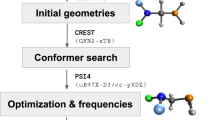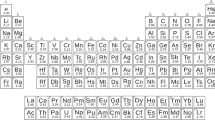Abstract
THE predictive power inherent in the concept of intrinsic bond energies has led to many attempts to calculate the energy of the hypothetical valence state of an atom in a molecule1–7. The intrinsic bond energy I can be defined1 by the equation:  where ΔHf is the atomic heat of formation of a molecule, V is the energy of the valence state of an atom, and the summation is over all atoms and bonds in the molecule. The valence state of an atom in a molecule can be defined as the hypothetical state in which the free atom would find itself if the bond involved were broken without any change in the electronic configuration of the atom. Long has summarized the attempt to calculate the valence state energy of the tetrahedral carbon atom from thermochemical data1. He concluded that the probable limits for the energy of this state are approximately 60–70 kcal/mole. This value is quoted6 as the only experimental value presently available for this quantity. (In several communications with people in this field it has been brought to our attention that this number is still widely quoted.)
where ΔHf is the atomic heat of formation of a molecule, V is the energy of the valence state of an atom, and the summation is over all atoms and bonds in the molecule. The valence state of an atom in a molecule can be defined as the hypothetical state in which the free atom would find itself if the bond involved were broken without any change in the electronic configuration of the atom. Long has summarized the attempt to calculate the valence state energy of the tetrahedral carbon atom from thermochemical data1. He concluded that the probable limits for the energy of this state are approximately 60–70 kcal/mole. This value is quoted6 as the only experimental value presently available for this quantity. (In several communications with people in this field it has been brought to our attention that this number is still widely quoted.)
This is a preview of subscription content, access via your institution
Access options
Subscribe to this journal
Receive 51 print issues and online access
$199.00 per year
only $3.90 per issue
Buy this article
- Purchase on SpringerLink
- Instant access to full article PDF
Prices may be subject to local taxes which are calculated during checkout
Similar content being viewed by others
References
Long, L. H., Experientia, 7, 195 (1951).
Voge, H. H., J. Chem. Phys., 16, 984 (1948); 4, 581 (1936).
Moffit, W., Proc. Roy. Soc., A, 202, 534 (1950).
Ellison, F. O., J. Chem. Phys., 36, 3107 (1962).
Opik, U., Mol. Phys., 4, 505 (1961).
Wilmhurst, J. K., J. Chem. Phys., 30, 889 (1959).
Pauling, L., Proc. U.S. Nat. Acad. Sci., 35, 229 (1949).
Cottrell, T. L., Strengths of Chemical Bonds, second ed. (Butterworths Sci. Pub., London, 1958).
Selected Values of Chemical Thermodynamic Properties, Circ. 500, U.S. Nat. Bur. Stand. (Washington, 1942).
Brewer, L., and Searcey, A. W., Ann. Rev. Phys. Chem., 7, 259 (1956).
Wilkinson, P. G., J. Mol. Spect., 6, 1 (1961).
Mulliken, R. S., et al., J. Chem. Phys., 17, 1248 (1949).
Herzberg, G., and Shoosmith, J., Canad. J. Phys., 34, 523 (1956).
Higuchi, J., J. Chem. Phys., 28, 527 (1958).
Obrien, C. J., et al., in Kinetics, Equilibria and Performance of High Temperature Systems, edit. by Bahn, G. S., and Zuckowsky, E., 5–17 (Butterworths Sci. Pub., London, 1960).
Herzberg, G., Spectra of Diatomic Molecules (Van Nostrand Co., New York, 1950).
Author information
Authors and Affiliations
Rights and permissions
About this article
Cite this article
SIEGEL, B., SIEGEL, S. Calculation of Valence State Energies from Thermochemical Data. Nature 199, 591 (1963). https://doi.org/10.1038/199591a0
Issue date:
DOI: https://doi.org/10.1038/199591a0



